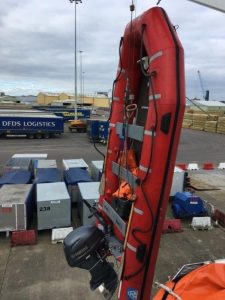The Charity
Aviation
Maritime
Rescue Boat Lifting Strops

Initial Report
Outline:
Rescue boat lifting strops were renewed but when refitted, were secured to the incorrect strongpoints, resulting in the potential for a serious incident to occur.
What the reporter told us:
The lifting strops for the vessel’s two inflatable rescue boats, (IRB’s), had recently been renewed. At the time of the incident the vessel was alongside, and the opportunity was taken for some familiarisation training. This included swinging out the port rescue boat. Unfortunately, the deck crew who had fitted the new strops attached the aft strops to strongpoints on the hull, and not to the correct lifting points on the transom. This resulted in an unstable lift as the weight of the outboard motor caused the boat to rotate about the aft strops and assume a vertical position, bow up, as shown in the photograph.

Company procedures require all boat launches which are carried out for training purposes, to be undertaken with fall preventer devices (FPD’s) in place. In addition, launching is to be preceded by swinging out, lowering, and recovering the boat empty. It was during this process that the problem was discovered when the boat assumed a vertical (bow up) position.
Once the port boat had been swung out over the ship’s side it was lowered a few metres, at which point the boat tilted to a vertical (bow up) position. The boat was subsequently recovered by attaching a heaving line to the bow which in turn was secured to the mooring deck, thus bringing the boat to the horizontal position for stowage.
With the boat fully secured, the lifting strops were measured against those in the starboard boat and found to be identical. A similar test was then carried out on the starboard rescue boat. As this boat was lifted from its cradle the forward lifting strops became slack, indicating an identical problem. The boat was re-stowed.
Investigation revealed that the aft strops on both boats had been attached to the wrong strongpoints on the hull and not to those on the transom. Having positively confirmed that this was the root cause, the strops were repositioned to the correct strongpoints, and both boats were successfully test launched.
The investigation determined that the crew members concerned were unsure of which strongpoints to use when refitting the strops and, unfortunately, chose not to seek clarification. In order to prevent a recurrence of this incident, the correct strongpoints were then permanently marked.
This incident is being reported because of the potential for serious injury (or worse). Had circumstances prevented testing of the boats after the replacement of the lifting strops, it is entirely possible that manned boats may have been deployed in an emergency situation (which overrides the use of FPD’s).
Whilst the changing of one piece of equipment with an identical certificated replacement may appear to be straightforward (and in this case, was not difficult), it is important that there is appropriate supervision and that such items are then cross-checked / tested before use.
When equipment is removed or replaced full notes/photographs should be taken and kept on board to ensure replacements are fitted correctly. On this occasion, it seems that further clarification was not sought when questions were raised amongst the crew who were refitting the strops.
CHIRP Comment:
Having discussed the report, the CHIRP Maritime Advisory Board agreed that this incident had the potential to cause an extremely serious accident. They highlighted the following;
It is good practice for vessel operating procedures to include photographs and accompanying notes in a clear logical order – these should be unambiguous. In this case, the procedures would include both the launching and recovery procedures, and the procedure for changing out the lifting strops. A picture is worth a thousand words and can be extremely helpful.
The above, coupled with a briefing and risk assessment prior to undertaking the task, would negate the Human Element comments in the report related to appropriate supervision and crew not clarifying the location of the strongpoints when refitting the strops.
In additional to any company or vessel procedures, it is vital that LSA / SOLAS training manuals should be fully up-to-date and that there should be a process for regular review. As a general comment to readers, CHIRP asks when YOU last took the opportunity to have a look at the manuals? Are they fit for purpose and up to date?
Whilst the colour coding of the strops was certainly an effective preventative measure, once again CHIRP highlights a design issue. The boats should have been designed so as to avoid this fundamental error. Naval architects and designers please take note.
Useful references:
Avoid Lifeboat Accidents – BIMCO – September 2017
Launching and Recovery of Boats from Ships – The Nautical Institute – January 2018
2017-12 Lifeboat Falls Paper. Lifeboat Incidents – A review of Issues – CHIRP
Report Ends………..







